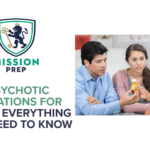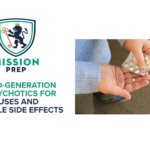The Definitive Guide to Chlorpromazine (Thorazine) for Teens

Imagine feeling like your thoughts are racing, your emotions are out of control, or the world around you doesn’t make sense – and not knowing why. That’s the reality for many teens struggling with severe mental health conditions. But help is available – sometimes that looks like therapy, other times that looks like a supportive community. Often, mental health treatment for teens comes in the form of a medicine that’s been around longer than your grandparents.
Chlorpromazine – also known by its brand name, Thorazine – is one of the oldest antipsychotic medications still being used to treat serious mental illness. But what does that mean for teens today? What should you, or someone you care about, know before starting this medication?
In this guide, we’ll explore teen mental health treatment with Chlorpromazine. We’ll explain what it is, how it works, why it’s prescribed to teens, and what side effects to watch out for – without all the confusing medical jargon. Whether you’re curious about Chlorpromazine, have recently been prescribed it, or want to support a loved one, this guide will help you understand everything you need to know about Thorazine.

What is Chlorpromazine?
Chlorpromazine (a.k.a Thorazine) has been used in the U.S. since the 1950s, first as a way to reduce anxiety before surgery, and then as an antipsychotic medication.1 It’s classed as a first-generation antipsychotic, or ‘typical’ antipsychotic, and can treat conditions where you have trouble telling the difference between what’s real and what isn’t, for example, if you have psychosis or schizophrenia.
It can also treat other emotional, mental, or behavioral issues, such as bipolar disorder, and agitation, and in some cases, it’s used for nausea or severe hiccups (yes, really!).2 Let’s look at how it can do all of this.
How Thorazine Works
Your brain is full of chemicals that help send messages between your nerve cells. One of the most important chemicals is called dopamine, which plays a big role in our moods. For some people, dopamine can get out of balance. If there is too much of it, you might have hallucinations or delusions – where you see, hear, or think things that aren’t real.
Imagine seeing a dog that isn’t really there, hearing someone whispering to you when you’re alone in a room, or believing that you have secret special powers – these are the kinds of symptoms we’re talking about.
Chlorpromazine works by stopping your brain from being overwhelmed by dopamine messages, which can help reduce confusing or scary symptoms, like hallucinations or delusions. It can also help you feel calmer.2
Is Thorazine FDA-Approved for Use in Teens?
Before we go into what conditions it can treat, let’s take a quick look at the difference between medications being FDA-approved or being used “off-label”. If a medication is FDA-approved, it means that the U.S. Food and Drug Administration (FDA) has said that it’s safe and effective for use in a certain group of people (such as adults or children) and for treating a certain condition (for example, schizophrenia).
The process for getting FDA approval can be expensive and lengthy, so sometimes the drug manufacturers don’t seek this approval for all uses of their medication, even if there is plenty of research to show it is safe and effective. In these cases, the medication would be used “off-label.”
Next, let’s explore what conditions it can treat in teens, and whether they are used off-label or FDA-approved.
What Conditions Does Chlorpromazine Treat in Teens?
Chlorpromazine might be an old antipsychotic, but it still plays a role in treating many difficult conditions in teens. It’s usually considered when other treatments haven’t been as effective as you hoped.
Chlorpromazine Dosage for Adolescents
Chlorpromazine usually comes in tablet form, to be swallowed with a glass of water. The tablets come in a range of doses, from 10 mg to 200 mg. Your doctor will decide which dose is best for you depending on the condition you have, but to give you an idea, the recommended dose for an adult can be between 40 mg to 200 mg each day, divided across the day.2,6
No matter your target dose, you will always start on a low dose so that your doctor can see how you react to it and monitor for any side effects. Your dosage can then be increased from there until you get the maximum benefit. Alternatively, if you are experiencing disruptive side effects, your doctor can adjust the dosage more slowly or consider other treatment options.
For this reason, it’s really important to attend your review appointments with your doctor – they won’t know how you are doing on this new medication unless you get the opportunity to update them.
Chlorpromazine Side Effects in Teenagers
Starting a new medication can be a big deal – it may be both exciting and worrying at the same time. It’s totally normal to wonder how taking Chlorpromazine will make you feel, what it helps, and what might feel more uncomfortable. Like all medications, Thorazine comes with the potential for side effects, and knowing what to expect can help you feel more prepared and in control.
Common Side Effects
Some side effects are more common and can be mild or go away over time as your body adjusts to the new medicine. The most common side effects of Chlorpromazine are:1,2,7
- Blurred vision
- Constipation
- Dizziness
- Drowsiness or sleepiness
- Dry mouth
- Urinary Retention
- Weight gain
Thorazine for Schizophrenia in Teens
Thorazine is FDA-approved for treating both adults and children with schizophrenia.3 However, second-generation antipsychotics, along with therapy and education about the condition, are typically offered first as they are often tolerated better than Thorazine.
Thorazine for Bipolar Disorder in Adolescents
Thorazine is FDA-approved for treating the mania aspects of bipolar disorder in adults and children.3,4 Mania means the abnormally excited moods that come with the ‘up’ episodes of bipolar disorder. Using Chlorpromazine for adolescent mood disorders can be effective, but it’s usually considered after other treatments haven’t been successful.
Chlorpromazine for ADHD Treatment in Teens
Chlorpromazine and Teen Behavior
Chlorpromazine is FDA-approved for the treatment of hyperactivity in adults and children.3 Again, it may be prescribed if the preferred treatments (ADHD stimulant and non-stimulant medications) haven’t been fully successful in treating the symptoms.
Chlorpromazine is FDA-approved in adults and children for treating severe behavioral problems, such as explosive and aggressive behavior.3 In this way, Thorazine for treating aggression in teens can be very effective when other medications haven’t worked.5
Thorazine and Other Conditions
As well as those already mentioned, Thorazine can be used off-label to control nausea and vomiting, to relieve long-lasting hiccups, and also to ease the nervousness that you may feel before having surgery.4
These effects can be annoying, but they’re often temporary. They tend to improve after a few weeks as the body adjusts to the medicine.
As you can see, there is a potential link between Thorazine and weight gain in teens, which can put some teens off. If you are worried about any of these side effects, speak to your doctor. They will be able to give you advice and look at any adjustments they can make to the medication.
More Serious Side Effects
Sometimes, Thorazine can cause more serious side effects that will need medical attention. Even though they are rarer, it’s important to know the signs:1
- Muscle stiffness or tremors
- Shuffling walk
- Tics
- Uncontrollable facial movements (a condition known as tardive dyskinesia, usually once you’ve been using Chlorpromazine for a long time)
- Extreme tiredness or confusion
- Fever, sweating, or very stiff muscles
If you notice these effects, it’s important to contact your doctor immediately.
Remember, everyone reacts to medications differently. Just because a side effect is listed as being common, it doesn’t mean you will have it. The most important thing is to keep attending your appointments with your doctor and to talk with them about how it is affecting you – the good, the bad, and the ugly. If they don’t know what you’re going through, they won’t be able to help you.
Stopping Thorazine Safely in Teens
At some point, you might not want to take Thorazine anymore. If this time comes, it’s essential that you don’t just stop taking it abruptly – it’s important to make a plan to slowly decrease the dose, with your doctor’s guidance.
You may wonder why you need to do this, especially as you might take other medications – like paracetamol or allergy tablets – as and when you need them without thinking about stopping them slowly. The difference is that if you suddenly stop taking Chlorpromazine, you could get some unpleasant effects called withdrawal symptoms.
Some of the most common Chlorpromazine withdrawal symptoms in adolescents are:4
- Dizziness
- Feeling shaky
- Nausea
- Stomach pains
- Vomiting
- Sleep problems
If you stop taking Chlorpromazine suddenly, you’re more likely to get withdrawal effects. If you reduce your dose slowly over time with your doctor’s help, you are less likely to experience them, and for them to be less bothersome if you do get withdrawal effects.
Frequently Asked Questions About Chlorpromazine
Is Chlorpromazine Safe for Teens?
It can be safe for teens when it’s been prescribed and monitored by a doctor. Regular check-ups will help make sure it’s working well and not causing harmful side effects.
Can I Take Thorazine and Still Go to School?
Yes, but it may make you feel drowsy at first. If that drowsiness doesn’t go away in the day, tell your doctor as they may be able to adjust the timing or the dosage to help you.
Do I Need to Take Thorazine Forever?
Not necessarily, it depends on why you are taking it and how well it works for you. Your doctor will work with you to decide what’s the best and safest thing for you to do.
Can I Stop Taking Chlorpromazine Once I Feel Better?
Yes, you can stop taking chlorpromazine if you choose to, but it’s advised that you speak to your doctor and organize a tapering plan. This involves slowly reducing the dosage or amount of medication you’re taking. If you stop taking thorazine suddenly, you might get withdrawal effects, so it’s always best to talk to your doctor before making changes to your medication.

Reach Out Today for Mental Health Support
Thorazine can play a vital role in treating severe mental health conditions, and having the right support, care, and knowledge will help you to start feeling like yourself again. That’s where Mission Prep comes in.
We specialize in working with teens and their families and understand that your mental health experiences are unique to you. Because of this, we create a treatment plan personalized to your symptoms and goals to help you feel better. We also know that medication is just one part of the mental health puzzle – there’s so much more that factors into your well-being. Whether you are looking for therapy, medication management, or family support, we offer a range of treatment programs including:
- Inpatient Programs: For highly structured 24/7 support and therapeutic interventions.
- Outpatient Programs: Allowing you to receive treatment while continuing school and home life.
- Intensive Outpatient Programs: A middle ground with structured support and therapy but without the overnight stays.
If you’re ready to get the help you need and deserve, contact us today to find out how we can support your healing journey.
References
- American Psychological Association. (n.d.). Chlorpromazine. APA Dictionary of Psychology. https://dictionary.apa.org/chlorpromazine
- Mann, S. K., & Marwaha, R. (2023, May 16). Chlorpromazine. StatPearls – NCBI Bookshelf. https://www.ncbi.nlm.nih.gov/books/NBK553079/
- Christian, R., Saavedra, L., Gaynes, B. N., Sheitman, B., Wines, R. C., Jonas, D. E., Viswanathan, M., Ellis, A. R., Woodell, C., & Carey, T. S. (2012, February 1). Tables of FDA-Approved Indications for First- and Second-Generation Antipsychotics. Future Research Needs for First- and Second-Generation Antipsychotics for Children and Young Adults – NCBI Bookshelf. https://www.ncbi.nlm.nih.gov/books/NBK84656/
- MedlinePlus. (n.d.). Chlorpromazine: MedlinePlus drug information. U.S. National Library of Medicine. https://medlineplus.gov/druginfo/meds/a682040.html
- Hoffmann, J. A., Pergjika, A., Konicek, C. E., & Reynolds, S. L. (2021). Pharmacologic management of acute agitation in youth in the emergency Department. Pediatric Emergency Care, 37(8), 417–422. https://doi.org/10.1097/pec.0000000000002510
- Medscape. (n.d.). Thorazine (chlorpromazine) dosing, indications, interactions, adverse effects, and more. https://reference.medscape.com/drug/chlorpromazine-342970#0
- Cleveland Clinic. (2024, December 19). Chlorpromazine tablets. https://my.clevelandclinic.org/health/drugs/18811-chlorpromazine-tablets



















